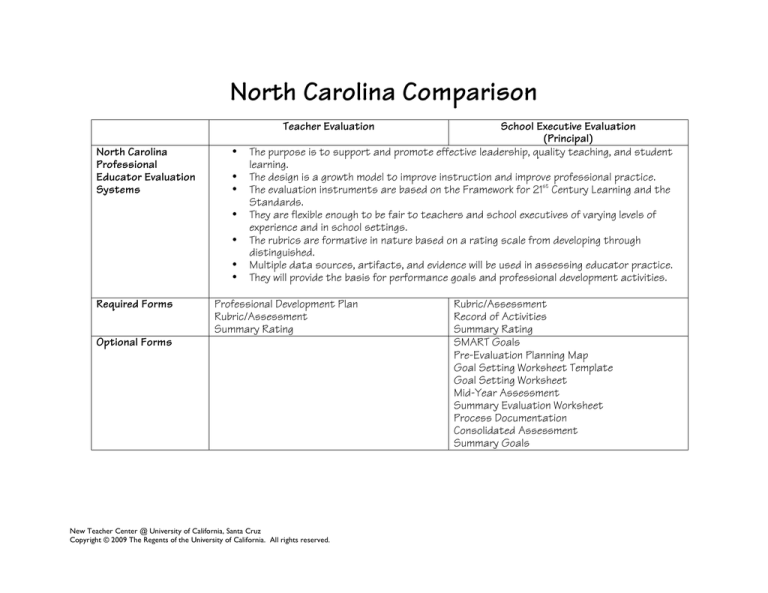
North Carolina Comparison
Teacher Evaluation
North Carolina
Professional
Educator Evaluation
Systems
•
•
•
•
•
•
•
Required Forms
School Executive Evaluation
(Principal)
The purpose is to support and promote effective leadership, quality teaching, and student
learning.
The design is a growth model to improve instruction and improve professional practice.
The evaluation instruments are based on the Framework for 21st Century Learning and the
Standards.
They are flexible enough to be fair to teachers and school executives of varying levels of
experience and in school settings.
The rubrics are formative in nature based on a rating scale from developing through
distinguished.
Multiple data sources, artifacts, and evidence will be used in assessing educator practice.
They will provide the basis for performance goals and professional development activities.
Professional Development Plan
Rubric/Assessment
Summary Rating
Optional Forms
New Teacher Center @ University of California, Santa Cruz
Copyright © 2009 The Regents of the University of California. All rights reserved.
Rubric/Assessment
Record of Activities
Summary Rating
SMART Goals
Pre-Evaluation Planning Map
Goal Setting Worksheet Template
Goal Setting Worksheet
Mid-Year Assessment
Summary Evaluation Worksheet
Process Documentation
Consolidated Assessment
Summary Goals
Performance Rating
Scale
Standards Areas
Timeline
(actual
dates will
vary)
Jul
Aug
Sep
Oct
Nov
Dec
Jan
Feb
Mar
Apr
May
Jun
Developing
Proficient
Accomplished
Distinguished
Not Demonstrated
1. Demonstrate leadership
1. Strategic Leadership
2. Establish a respectful environment for a
2. Instructional Leadership
diverse population of students
3. Cultural Leadership
3. Know the content
4. Human Resource Leadership
4. Facilitate learning for students
5. Managerial Leadership
5. Reflect upon practice
6. External Development Leadership
7. Micro-Political Leadership
Pre-evaluation planning, self-assess
Orientation
Final goals meeting w/supervisor
Self assessment w/rubric, Prof. Dev. Plan
Artifact collection Sep-May
Pre-obs. conf, obs, and post-obs. conf.
NOTE: First observation must be announced, balance not. Prob.
Teachers must be formally observed 4x a year including one peer obs.
Career status teachers in formal year are observed 3x a year, including
one formal obs. Post-obs conference within ten days of observation.
Mid-year update
Summary evaluation conference
Professional development plan for following yr.
Develop consolidated assessment
Final conference and summary form
New Teacher Center @ University of California, Santa Cruz
Copyright © 2009 The Regents of the University of California. All rights reserved.
